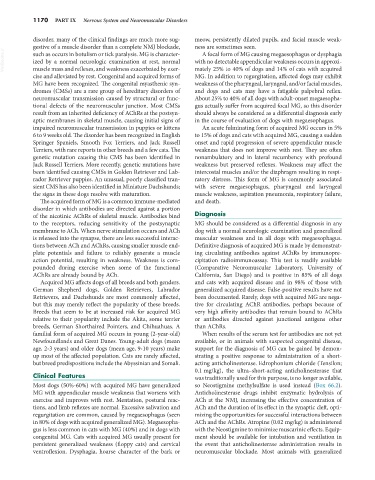Page 1198 - Small Animal Internal Medicine, 6th Edition
P. 1198
1170 PART IX Nervous System and Neuromuscular Disorders
disorder, many of the clinical findings are much more sug- meow, persistently dilated pupils, and facial muscle weak-
gestive of a muscle disorder than a complete NMJ blockade, ness are sometimes seen.
VetBooks.ir such as occurs in botulism or tick paralysis. MG is character- with no detectable appendicular weakness occurs in approxi-
A focal form of MG causing megaesophagus or dysphagia
ized by a normal neurologic examination at rest, normal
muscle mass and reflexes, and weakness exacerbated by exer-
MG. In addition to regurgitation, affected dogs may exhibit
cise and alleviated by rest. Congenital and acquired forms of mately 25% to 40% of dogs and 14% of cats with acquired
MG have been recognized. The congenital myasthenic syn- weakness of the pharyngeal, laryngeal, and/or facial muscles,
dromes (CMSs) are a rare group of hereditary disorders of and dogs and cats may have a fatigable palpebral reflex.
neuromuscular transmission caused by structural or func- About 25% to 40% of all dogs with adult-onset megaesopha-
tional defects of the neuromuscular junction. Most CMSs gus actually suffer from acquired focal MG, so this disorder
result from an inherited deficiency of AChRs at the postsyn- should always be considered as a differential diagnosis early
aptic membranes in skeletal muscle, causing initial signs of in the course of evaluation of dogs with megaesophagus.
impaired neuromuscular transmission in puppies or kittens An acute fulminating form of acquired MG occurs in 5%
6 to 9 weeks old. The disorder has been recognized in English to 15% of dogs and cats with acquired MG, causing a sudden
Springer Spaniels, Smooth Fox Terriers, and Jack Russell onset and rapid progression of severe appendicular muscle
Terriers, with rare reports in other breeds and a few cats. The weakness that does not improve with rest. They are often
genetic mutation causing this CMS has been identified in nonambulatory and in lateral recumbency with profound
Jack Russell Terriers. More recently, genetic mutations have weakness but preserved reflexes. Weakness may affect the
been identified causing CMSs in Golden Retriever and Lab- intercostal muscles and/or the diaphragm resulting in respi-
rador Retriever puppies. An unusual, poorly classified tran- ratory distress. This form of MG is commonly associated
sient CMS has also been identified in Miniature Dachshunds; with severe megaesophagus, pharyngeal and laryngeal
the signs in these dogs resolve with maturation. muscle weakness, aspiration pneumonia, respiratory failure,
The acquired form of MG is a common immune-mediated and death.
disorder in which antibodies are directed against a portion
of the nicotinic AChRs of skeletal muscle. Antibodies bind Diagnosis
to the receptors, reducing sensitivity of the postsynaptic MG should be considered as a differential diagnosis in any
membrane to ACh. When nerve stimulation occurs and ACh dog with a normal neurologic examination and generalized
is released into the synapse, there are less successful interac- muscular weakness and in all dogs with megaesophagus.
tions between ACh and AChRs, causing smaller muscle end- Definitive diagnosis of acquired MG is made by demonstrat-
plate potentials and failure to reliably generate a muscle ing circulating antibodies against AChRs by immunopre-
action potential, resulting in weakness. Weakness is com- cipitation radioimmunoassay. This test is readily available
pounded during exercise when some of the functional (Comparative Neuromuscular Laboratory, University of
AChRs are already bound by ACh. California, San Diego) and is positive in 85% of all dogs
Acquired MG affects dogs of all breeds and both genders. and cats with acquired disease and in 98% of those with
German Shepherd dogs, Golden Retrievers, Labrador generalized acquired disease. False-positive results have not
Retrievers, and Dachshunds are most commonly affected, been documented. Rarely, dogs with acquired MG are nega-
but this may merely reflect the popularity of these breeds. tive for circulating AChR antibodies, perhaps because of
Breeds that seem to be at increased risk for acquired MG very high affinity antibodies that remain bound to AChRs
relative to their popularity include the Akita, some terrier or antibodies directed against junctional antigens other
breeds, German Shorthaired Pointers, and Chihuahuas. A than AChRs.
familial form of acquired MG occurs in young (2-year-old) When results of the serum test for antibodies are not yet
Newfoundlands and Great Danes. Young-adult dogs (mean available, or in animals with suspected congenital disease,
age, 2-3 years) and older dogs (mean age, 9-10 years) make support for the diagnosis of MG can be gained by demon-
up most of the affected population. Cats are rarely affected, strating a positive response to administration of a short-
but breed predispositions include the Abyssinian and Somali. acting anticholinesterase. Edrophonium chloride (Tensilon;
0.1 mg/kg), the ultra–short-acting anticholinesterase that
Clinical Features was traditionally used for this purpose, is no longer available,
Most dogs (50%-60%) with acquired MG have generalized so Neostigmine methylsulfate is used instead (Box 66.2).
MG with appendicular muscle weakness that worsens with Anticholinesterase drugs inhibit enzymatic hydrolysis of
exercise and improves with rest. Mentation, postural reac- ACh at the NMJ, increasing the effective concentration of
tions, and limb reflexes are normal. Excessive salivation and ACh and the duration of its effect in the synaptic cleft, opti-
regurgitation are common, caused by megaesophagus (seen mizing the opportunities for successful interactions between
in 80% of dogs with acquired generalized MG). Megaesopha- ACh and the AChRs. Atropine (0.02 mg/kg) is administered
gus is less common in cats with MG (40%) and in dogs with with the Neostigmine to minimize muscarinic effects. Equip-
congenital MG. Cats with acquired MG usually present for ment should be available for intubation and ventilation in
persistent generalized weakness (floppy cats) and cervical the event that anticholinesterase administration results in
ventroflexion. Dysphagia, hoarse character of the bark or neuromuscular blockade. Most animals with generalized

